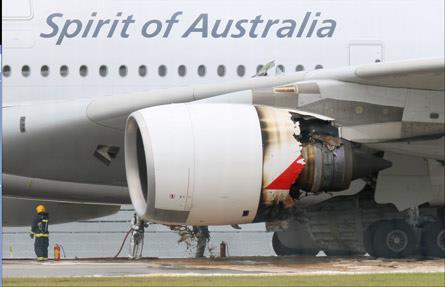Originally posted by MCM
View Post
Announcement
Collapse
No announcement yet.
Qantas A380 Engine Failure
Collapse
X
-
Ha, ha, it's now been reduced to just 2 cycles too many.Originally posted by Evan View PostFinally, on November 10th, after the explosion, they issued an AD specifically identifying the area of the problem and requiring inspection compliance within 10 cycles (which is exactly 10 cycles too many)
...
It also would mean that the EASA has continuously been very lenient with their compliance requirements on this issue, even up to the recent 10 cycle before inspection allowance.
~ from CockpitCat's link to AVHerald above.The Australian Transportation Safety Board reported, that on Dec 2nd Rolls Royce released a new revision of its non-modification service bulletin (NMSB) 72-G595 defining assessment and engine rejection criteria for the measurement of potential oil feed stub pipes counter-bore misalignment. At the same time the NMSB tightened the compliance time frame from 20 to 2 flight cycles.
Comment
-
Qantas Airways will resume Airbus A380 flights between Australia and Los Angeles from January 16, the airline said on Tuesday.
Qantas said in a statement the decision followed extensive consultation with engine maker Rolls-Royce, aircraft manufacturer Airbus and the Australia's Civil Aviation Authority.
Qantas was forced to initially ground its fleet of A380 aircraft after an engine in one of the aircraft disintegrated mid-flight in November.
It has since resumed some A380 flights but was not flying the aircraft on the route to and from Los Angeles, which had required the use of maximum engine thrust on takeoff.
Comment
-
 EXCLUSIVE - Qantas QF32 flight from the cockpit | Aerospace Insight | The Royal Aeronautical SocietyExclusive interview with one of the flight crew of Qantas A380 flight QF32 who gives the view from the flight deck of this extraordinary aviation incident.
EXCLUSIVE - Qantas QF32 flight from the cockpit | Aerospace Insight | The Royal Aeronautical SocietyExclusive interview with one of the flight crew of Qantas A380 flight QF32 who gives the view from the flight deck of this extraordinary aviation incident.
Very interesting reading!
Comment
-
Holy crap! What a terrific job that crew did! Just listened to the soundtrack - absolutely fascinating. That engine that they couldn't shut down - it ran for another 5hrs before the fire services stopped it.Originally posted by CockpitCat View PostYet another AD.com convert!
Comment
-
Great interview. It asks and answers a lot of the questions I had in my head.
It also shows the supreme value of experience under pressure.
I would like to see two recommendations:
- a guarded manual ground shut-down switch on the lower engine nacelle.
- a recognition that airstairs are part of the emergency response equipment, and therefore a means of delivering them more expeditiously is needed. Capt. Evans mentions that the decision not to deploy the slides was one of the most difficult. It must have been a tense wait for the stairs to show up. Had a fire erupted in the wing gear bay, things could have gone quite differently.
Comment
-
A guarded manual shut down switch on the nacelle?
You've got fuel running everywhere, a clearly severely damaged aeroplane, tyres that are overheated and likely to give way at any moment (meaning you cannot approach the aircraft from the side), and you're proposing someone walks upto an engine to switch it off? Really?
How about faulty switch wires give way in turbulence?
Do you really want to provide another way for an engine to fail, while not really providing any increased benefit? (After all, if the two main ways of shutting down an engine fail, whats to say that a third would work?)
Comment
-
The saga continues.
The ATSB just released their final bulletin on the Qantas A388 that landed in London on February 15th, 2011 with only .7 quart of engine oil remaining on the #4 mill. In conducting the fleetwide boroscope engine inspections following the Singapore incident, it seems a certain oil pipe attachment fitting was incorrectly torqued in at least 7 instances. The inspections themselves, carried out for the purpose of detecting oil leaks, led to seven additional incidents of oil leakage. Brilliant.
Originally posted by Aviation HeraldThe ATSB released their final bulletin reporting that the aircraft was enroute near Delhi (India) about 3 hours into the flight when the crew noticed the oil quantity for the #4 engine decreased and continued to gradually decrease. About 7.5 hours into the flight the oil quantity had dropped to 3.5 quarts and the oil pressure reduced from 100 psi to 75 psi. After consultation with maintenance the crew reduced engine #4 to idle thrust which prompted the oil quantity to stabilize with the pressure at 45 psi. The flight continued to London where the aircraft landed safely about 13:50 hours after departure. Only 0.7 quarts of oil remained for engine #4.
An inspection found an oil leak from an external high pressure/intermediate pressure (HP/IP) oil tube at its connection to the engine case. A b-nut on that tube was found torqued at 80 lbf/in while the correct torque was 240 lbf/in. The tube was replaced.
The investigation found that the operator's A380 engines had been subject to a number of inspections following an uncontained engine failure of VH-OQA, see: Accident: Qantas A388 near Singapore on Nov 4th 2010, uncontained engine failure. These inspections included the removal of the HP/IP tube to provide access for borescopic inspections of the engine. Specific torque procedures for the reinstallation of the HP/IP tube were required.
Such an inspection had been carried out on the incident engine 20 days prior to the oil leak developing. The engine had accumulated 20 cycles and 241 hours since that inspection, no maintenance had been carried out in that time.
The ATSB annotated that this was not an isolated event, 7 oil leaks were identified caused by low torque of the oil attachment fitting, all of which followed borescopic inspections.
The ATSB has initiated a holistic investigation into the factors surrounding these failures.
Comment
-
I work on very high vibration (>200 grms) aerospace vehicles and B-nuts routinely come loose and leak unles they are lockwired (if no lock-wire holes we use a 'champagne cork' lockwiring method). The only reason I don't worry about B-nuts on aircraft is that systems are redundant.............. A b-nut on that tube was found torqued at 80 lbf/in while the correct torque was 240 lbf/in. The tube was replaced.
...................
The ATSB has initiated a holistic investigation into the factors surrounding these failures.
I also know that some US aircraft companies insist on Dynatube fittings for use around engines.
I can see why "Holistic" fits here but it is the first time I ever saw it used in a non-medical sense.
Comment
-
Work will begin next week, on the repair of Qantas’ first A380 (MSN014), which suffered an uncontained engine failure on a Sydney to Singapore service in November last year.
Cheers,
Oliver Gigacz
Comment


Comment